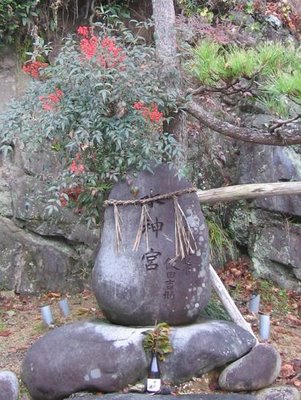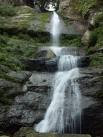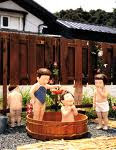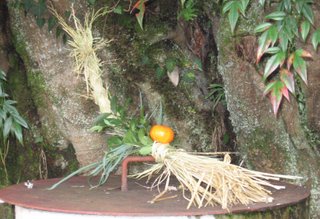:::::::::::::::::::::::::::::::::::::::::::::::::::::::::::::::::::::::::::::::::::::::::::::::::::::
Water (mizu)
***** Location: Japan, Worldwide
***** Season: Various, see below
***** Category: Earth
*****************************
Explanation
WATER just like that (mizu, sui 水 ) is not a kigo in Japan but a nonseasonal topic.
But since water is a constant necessity throughout the year, there are many detailed phenomenon used as kigo for it. And in olden times with no tabwater, this comodity was really important for the continuation of life.
Let us go through the seasons.
I also add some Japanese kigo with the word WATER as part of the description of something else.
xxxxxxxxxxxxxxxxxxxxxxxxxxxxxxxxxxxxxxxxxxxxxxxxxxxxxxxxxx
The goodwill of the God of Water is very important to a ricegrowing and farming society.

The God of Water, Suijin 水神様
God of the Fields (田の神) and related kigo
Kappa, the Water Goblin of Japan 河童 and Haiku
:::::::::::::::::::::::::::::::::::::::::::::::::::::::::::::::::::::::::::::::::::::::::::::::::::::
SPRING
Ceremony of Opening the Water Channels to the rice paddies
..... mizuguchi matsuri 水口祭
Ceremony of drawing the first sacred water お水取り,
Temple Todai-ji, Nara
Skunk Cabbage (mizu bashoo)
.................................................................................
. water in spring, haru no mizu 春の水 .
shunsui 春水、mizu no haru 水の春
"water in spring" refers to water getting warmer and more pleasant. With the snowmelt, rivers, ponds and lakes get full and the rays of the sun reflect pleasantly on it. It is the water of life for all beings.
. Yosa Buson 与謝蕪村 .
春水や四条五条の橋の下
shunsui ya Shjoo Gojoo no hashi no shita
water of spring -
at Shijo and Gojo
under the bridges
Two famous bridges in
. Kyoto (Hana no Miyako) .
春の水すみれつばなをぬらし行
haru no mizu sumire tsubana o nurashi-yuku
Water of spring,
violets and white flowered reeds
moistened as it flows.
Tr. Sawa and Shiffert

. tsubana 茅花 (つばな) Chigaya flowers .
kigo for mid-spring
春の水山なき国を流れけり
haru no mizu yamanaki kuni o nagarekeri
The water in spring
Through the hill-less countryside
Meanders.
Tr. Nelson and Saito
.................................................................................
snow meltwater, yukige mizu 雪解水
..... yukishiro mizu 雪しろ水
Water gets warmer, waters warm up, waters warming
mizu nurumu 水温む
..... nurumu mizu 温む水
kigo for mid-spring
:::::::::::::::::::::::::::::::::::::::::::::::::::::::::::::::::::::::::::::::::::::::::::::::::::::
SUMMER
natsu no mizu 夏の水 (なつのみず) water in summer
Represents all kinds of water, drinking water, water used in the home and also in the fields.
Water was a precious commodity in the old days, depending on rain, springs and wells.
spring, fountain, izumi 泉
... ... ... shimizu 清水 clear water
clear water, fresh spring water in summer, shimizu 清水
..... draw well water, shimizu kumu 清水汲む(しみずくむ)
Water in the rice paddies needs work:
..... to dam in the water, shimizu seku 清水堰く(しみずせく)
..... connecting the water, shimizu muzubu 清水掬ぶ(しみずむすぶ)
fresh mountain water, yama shimizu 山清水
fresh water from the rocks, iwa shimizu 岩清水
fresh water from moss, koke shimizu 苔清水(こけしみず)
fresh water from a deep valley, soba shimizu 岨清水(そばしみず)
clear water on the beach, iso shimizu 磯清水(いそしみず)
..... soko shimizu 底清水(そこしみず)
clear water in the home, ie shimizu 家清水
clear water at the corners (of an estate), kado shimizu 門清水(かどしみず)
clear water in the garden, niwa shimizu 庭清水(にわしみず)
clear water in a temple, tera shimizu 寺清水(てらしみず)
not to confuse with the famous temple in Kyoto, Kiyomizudera 清水寺, see below.
fresh water in the morning, asa shimizu 朝清水
fresh water in the evening, yuu shimizu 夕清水(ゆうしみず)
stall selling tea made with fresh water
..... shimizujaya, shimizu chaya 清水茶屋(しみずぢゃや)
. chaya, -jaya 茶屋 tea shop, tea stall .
... ... ...
. Floods, flooding, demizu 出水 .
Jelly Bean Cake (mizu yookan 水羊羹) Japan
Playing in water, mizu asobi 水遊び
..... This can be in rivers, lakes or at the sea in salt water. Also BEACH and beach life kigo.
Sprinkling Water (uchimizu, Japan)
sansuisha 撒水車 (さんすいしゃ) water sprinkling car
Trickling water, dripping water, shitatari 滴り
..... finely dripping water, kenteki 涓滴(けんてき)
..... dripping from the mountain, yama shitatari山滴り(やましたたり)
..... dripping from the rocks, iwa shitatari 巌滴り(いわしたたり)
..... dripping from a cliff, gake shitatari 崖滴り(がけしたたり)
..... dripping from the moss, koke shitatari 苔滴り(こけしたたり)
Water lily, suiren 水蓮
Watermelon, suika スイカ 西瓜
Water Strider, water boatman, water spider, water horse (amenbo 水馬) Japan
..... also whirligig beetles, mizusumashi 水澄
.................................................................................
. Waterfall, taki 滝 / baku 瀑
looking at a waterfall, takimi 滝見(たきみ)
teahouse at a waterfall, takimi chaya 滝見茶屋
bottom basin of a waterfall, takitsub9o 滝壺(たきつぼ)
foam from a waterfall, taki shibuki 滝しぶき(たきしぶき)
breeze of a waterfall , takikaze 滝風
sound of the waterfall, taki no oto 滝の音(たきのおと)
path to the waterfall, takimichi 滝道(たきみち)
two falls like a couple, myotodaki 夫婦滝(みょうとだき)
..... male waterfall, odaki 男滝(おだき)、
..... female waterfall medaki 女滝(めだき)
waterfall at night, yodaki 夜滝
coolness at a waterfall, taki suzushi 滝涼し(たきすずし)
bath in a waterfall, taki abi 滝浴び(たきあび)
wild waterfall, bakufu 瀑布(ばくふ)
"flying waterfall", hibaku 飛瀑(ひばく)
manmade waterfall, tsukuridaki 作り滝(つくりだき)
 瀑五段一段毎の紅葉かな
瀑五段一段毎の紅葉かなbaku godan ichidan goto no momiji kana
five-tiered waterfall -
by each tier there are
red maple leaves
Natsume Soseki 漱石, composed in 1895
Tr. Gabi Greve
Shirai no Taki Waterfall 白猪(しらい)の滝
Karakai no Taki 唐岬の滝 near Matsuyama.
(five terraced waterfalls)
NEXT
Waterfall, kigo for all seasons
.................................................................................
Well cleaning (sarashi-i 晒井 さらしい)
"changeing the well", ido gae 井戸替(いどがえ)
.................................................................................
humanity kigo for late summer
. mizukyoogen, mizu kyoogen
水狂言 (みずきょうげん) "water kyogen"
..... mizugei 水芸(みずげい) acrobatic tricks with water, performances
. mizu arasoi 水争 (みずあらそい) fighting for water
many KIGO for the farmers worrying about water during a dry spell
and giving thanks to a rainfall after it
.................................................................................
hinatamizu, hinata mizu 日向水 (ひなたみず)
water warmed by the sun
日向水ひろごる雲をうつしけり
hinatamizu hirogoro kumo o utsushi-keri
water warmed by sunshine . . .
in the afternoon it reflects
the clouds
Kubota Mantaro 久保田万太郎
. . . . .

gyoozui 行水 (ぎょうずい) children taking a bath in a bathtub
Especially enjoyed by small children in the garden
In the Edo period during the summer months, folks could enjoy a splash outside, but with the arrival of colder days, this pleasure was over.
行水も日まぜになりぬむしのこゑ
gyôzui mo himaze ni narinu mushi no koe
bathing outside
occurs only every second day now -
these sounds of insects
Konishi Raizan 小西来山 (1654 - 1716) Mitsuhira 満平

. The Water Supply of Edo .
. . . . .
yosusugi 夜濯 (よすすぎ) washing in the evening
During the Edo period, it was common to wash the sweaty cloths in the cooler evening and hang them for drying over night.
夜濯の更け来し水の澄みわたり
Nakamura Teijo 中村汀女
.................................................................................
. SAIJIKI ... category EARTH
Kigo for Summer
.................................................................................
humanity kigo for all summer
joro 如露 (じょろ) watering can, Giesskanne
..... jouro, jo-u-ro 如雨露(じょうろ)
. . . CLICK here for Photos !

mizu-uri 水売 (みずうり) vendor of water
hiyamizu uri 冷水売(ひやみずうり) vendor of cold water
koorimizu uri 氷水売り vendors of "ice water"
This was an important job in the Edo period, when there were no supermarkets or vending maschines on every corner.
They usually started their job around the 5th lunar month.
..... koori uri 氷売 (こおりうり) vendor of ice blocks
toshiyori no hiyamizu 年寄りの冷や水 to do something imprudent for an old person
derived from this habit.
水売りは一つか二つ錫茶碗
水売りは一つか二つ鈴茶碗
mizu-uri wa hitotsu ka futatsu suzu chawan
the water vendor
has one or maybe two
tin cups
Tin cups did not break easily and kept the water cool.
The vendors were dressed in fancyful robes, to look cool themselves.
They drew water from deep wells, but it was soon warm in the hot climate of summer in Edo.

. Food vendors in Edo .
ひやつこい ひやつこい hiyakkoi hiyakkoi
Here comes the cold delight !
One bowl was 4 mon, and if the client wanted more white sugar in the brew, it might cost im 8 or even 12 mon.
. shiratama uri 白玉売 vendor of Shiratama sweets .
also selling cold water

hiyamizu uri 冷や水売り selling cold drinking water
. koorimizu uri 氷水売り vendor of "ice water" - senryu
- - - - -
shawaa シャワー shower
Taking a shower, this custom is rather new, since the Meiji period.
Dusche, duschen
.SAIJIKI ... HUMANITY
Kigo for Summer
:::::::::::::::::::::::::::::::::::::::::::::::::::::::::::::::::::::::::::::::::::::::::::::::::::::
AUTUMN
. aki no mizu 秋の水 (あきのみず) water in autumn
..... shuusui 秋水 (しゅうすい)
..... mizu no aki 水の秋 (みずのあき)
mizu sumu 水澄む clear autumn water, water clears
. autumn floods, aki demizu 秋出水 (あきでみず) .
:::::::::::::::::::::::::::::::::::::::::::::::::::::::::::::::::::::::::::::::::::::::::::::::::::::
WINTER
kigo for all winter
mizu karu 水涸る (みずかる) water dries up
kassuiki 渇水期(かっすいき)season where water dries up
kawa karu 川涸る(かわかる)river dries up
..... karegawa 涸川(かれがわ)
numa karu 沼涸る(ぬまかる)swamp dried up
..... karenuma 涸沼(かれぬま)
ike karu 池涸る(いけかる)pond dries up
..... kareike 涸池(かれいけ)
kei karu 渓涸る(たにかる)gorge dries up
taki karu 滝涸る(たきかる)waterfall dries up
..... karedaki 涸滝(かれだき)
.................................................................................
fuyu no mizu 冬の水 (ふゆのみず) water in winter
mizu kemuru 水烟る(みずけむる)"water is smoking"
The water is dark like smoke from a woodfire.
. fuyu no izumi 冬の泉 spring in winter
.................................................................................
Water birds, mizudori 水鳥
.................................................................................
kigo for late winter
kan no mizu 寒の水 (かんのみず) water in the cold
..... kanku no mizu 寒九の水(かんくのみず)
kanku 寒九 the coldest time of winter
HAIKU about Sake and Mountains
Suganadake ha ni shimitooru kanku kana
. SAIJIKI ... category EARTH
.................................................................................

fuyudaki 冬滝 (ふゆだき) waterfall in winter
..... fuyu no taki 冬の滝(ふゆのたき)
itedaki 凍滝(いてだき)frozen waterfall
kooritaki 氷り滝(こおりたき)ice waterfall
kan no taki 寒の滝(かんのたき)waterfall in the cold
taki kooru 滝凍る(たきこおる)waterfall is frozen
In the colder parts of Northern Japan frozen waterfalls are a most splendid sight.
. . . CLICK here for Photos !
:::::::::::::::::::::::::::::::::::::::::::::::::::::::::::::::::::::::::::::::::::::::::::::::::::::
NEW YEAR
First Water, "young water" (wakamizu)

New Year decoration of a rural well in Japan
© Gabi Greve, Okayama, Japan. January 2007
*****************************
Worldwide use
Kenya
Cold water
*****************************
Things found on the way
"Clear Water Temple" Kiyomizudera, Kyoto
Pure Water Temple
"Enchin, a priest from Nara, was told in a vision to "Look for the clear water origin of the Yodo river". In a long search, he stumbled upon a place deep in the forest greenery where a mist, like a belt of white clouds, hung over a waterfall at the foot of Mt. Otowa."
According to the legend, Enchin received a vision that said he would find at the source of the Yodo river, a clear source of water. During his search Enchin came across a hermit named Gyoei. Gyoei was a old priest practising ascetism and he gave Enchin a piece of wood possessed by the spirit of the Kannon Bosatsu. This was then carved into the likeness of the Kannon and Enchin then enshired the image in a small thatched roofed hut.
This was the begining of Kiyomizudera. The legend also says that the hermit disappeared, and that when Enchin later found the hermit's sandals on top of the mountain, he realized that he had actually been speaking with a manifestation of the Kannon. On the other hand, the hermit may just have wanted some peace and quiet.
The legend continues that Sakanoue Tamuramaro, one of the emperor's leading generals came upon Enchin while deer hunting. The blood of a stag was thought to ease the pain the childbirth, and Tamuramarro's wife was about to give birth. Enchin spoke of the cruelty of killing animals (forbidden in the Buddhist tradition) and his speech so moved Tamuramaro that to repent, Tamuramaro underwrote the construction of a proper sanctuary. (Another story is that he disassembled his home and gave it to the temple, building a new house to replace it).
In 794 the emperor Kammu moved his capital to Kyoto and gave Tamuramaro his throne hall as a reward for his military service. As a devout worshipper of Kannon he proceeded to donate the building to Enchin for a new main hall. The building stood until 1629 until it was destroyed by fire. Today's Main Hall has roof made of cypress, not the traditional tile, in remembrance of originally being part of the emperor's palace. Most of the buildings today were rebuilt by Iemitsu Tokugawa, the 3rd shogun of the Tokugawa Shogunate, in 1633.
Read more here :
© copyright The Yamasa Institute, Hattori Foundation

© Photo by Christopher Buchanan
Visitors drink from the sacred water of Kiyomizudera, said to bring health and good
fortune.
:::::::::::::::::::::::::::::::::::::::::::::::::::::::::::::::::::::::::::::::::::::::::::::::::::::
Sound of Water (mizu no oto) Japan a famous haiku phrase
Suiteki 水滴 water drippers for calligraphy
*****************************
HAIKU
田の水やさらばさらばと井にもどる
ta no mizu ya saraba saraba to i ni modoru
rice paddy drains--
goodbye! goodbye!
back to the well
More Issa Haiku about rice paddies
(tr. David Lanoue)
:::::::::::::::::::::::::::::::::::::::::::::::::::::::::::::::::::::::::::::::::::::::::::::::::::::
like a leaf
floating in clear water -
a samurai's life
Gabi Greve
Click HERE to read the details.
:::::::::::::::::::::::::::::::::::::::::::::::::::::::::::::::::::::::::::::::::::::::::::::::::::::
horo horo to yamabuki chiru ka taki no oto
Petals of the mountain rose
Fall now and then,
To the sound of the waterfall
Matsuo Basho
http://www.takase.com/Haiku/Haiku.htm
:::::::::::::::::::::::::::::::::::::::::::::::::::::::::::::::::::::::::::::::::::::::::::::::::::::
blinding rain -
waterfall among the pines
is singing again
Sunil Uniyal, New Delhi, India
Kigo Hotline, June 2009
*****************************
Related words
***** Rain in various KIGO
***** Rain Rituals (amagoi) Rain Dance, Rain Prayer
***** Snow (yuki)
***** Sound of Water (mizu no oto) Japan
A famous haiku line and its translation problems
***** Water Shortage (Tropics)
Waterfalls and Fudo Myo-o 不動滝
:::::::::::::::::::::::::::::::::::::::::::::::::::::::::::::::::::::::::::::::::::::::::::::::::::::
. River (kawa)
se 瀬 rapid, rapids
asase, kawase 川瀬, hayase 早瀬
Stromschnelle
se o kudaru 瀬を下る driving down a rapid
:::::::::::::::::::::::::::::::::::::::::::::::::::::::::::::::::::::::::::::::::::::::::::::::::::::
WASHOKU ... Japanese Food SAIJIKI ... Drinking Water
. SAIJIKI ... category EARTH
. Rain in various kigo (ame 雨) .
including the Rainy Season and Typhoon
. River (kawa 川) in various kigo .
spring at the sea, haru no umi 春の海
. Beach (biichi), Shore (nagisa) in all seasons .
:::::::::::::::::::::::::::::::::::::::::::::::::::::::::::::::::::::::::::::::::::::::::::::::::::::
[ . BACK to DARUMA MUSEUM TOP . ]
[ . BACK to WORLDKIGO . TOP . ]
:::::::::::::::::::::::::::::::::::::::::::::::::::::::::::::::::::::::::::::::::::::::::::::::::::::






9 comments:
sleepy in spring ー
the water of our well
drips steadily
Gabi Greve
http://groups.yahoo.com/group/simply_haiku/message/19354
.
山里は米をつかする清水かな
yama-zato wa kome o tsukasuru shimizu kana
mountain village--
pure water
husks the rice
Issa / Tr. David Lanoue / http://cat.xula.edu/issa/
Quote from http://www.doshinmartialarts.com/mikami_2.htm
.................................
Mind Like Water
Takayuki Mikami
Water, which is crucial to our survival has qualities that far transcend it's most basic functions. Looking at some of it's characteristics one realizes that is far more than a "thirst quencher".
Water has the ability to adapt itself totally to it's environment. When the temperature gets too high it becomes steam and it changes to ice when things are too cold. It can also change it's shape to conform to that of the container. What is remarkable about water, is that it manages to maintain its identity under the most varied circumstances.
Water is everflowing and always manages to find its level. When something comes in the way it goes around and takes the path of least resistance. On those occasions where an obstacle seems insurmountable it steadily gains strength and force until it finally overcomes.
No matter how high a dam is built on a stream... eventually the stream overflows the dam. There is an unyielding and steady effort that water generates which regards all obstacles, no matter how high or big, as being temporary.
Finally, calm water is like a mirror and gives a picture of all that is around. Conversely troubled waters only reflect the turmoil within. When a person approaches a problem with calm and composure then like the reflection on calm water he sees everything. So also when a problem causes turmoil then like the troubled water on confusion is seen.
Imagine an intellect as calm, a will as relentless and indomitable and a personality as adaptable as water and you will have envisioned a MIND LIKE WATER>
translation by Ashok Ghildya
sluicing in
to fill the bath...
pure water
suifuro e nagashi kondaru shimizu kana
.水風呂へ流し込だる清水哉
by Issa, 1819
Nobuyuki Yuasa explains: "The bathtub was placed outside the house, and water was flowing into it probably through a bamboo pipe"; The Year of My Life: A Translation of Issa's Oraga Haru, 2nd Edition (Berkeley: Univ. of California Press, 1972) 58. Issa copies this haiku into his journal Oraga haru ("My Spring") with the prescript, "Mount Tokage." In other texts he prefaces it with "In Mount Tokage's mansion." Mount Tokage lies to the west of Issa's home village of Kashiwabara.
In this location the Shinto god Tokage's festival is celebrated; Issa zenshu^ (Nagano: Shinano Mainichi Shimbunsha, 1976-79) 6.168, note 74.
Tr. David Lanoue
.
玉垣の中より神の岩清水
tamagaki no naka yori kami no iwa shimizu
within the shrine fence
fresh water flows
from the rock of the Gods
Fujita Seiko 藤田静古
MORE about the shrine fences
Yosa Buson
石工の鑿冷したる清水かな
sekkoo no nomi hiyashitaru shimizu kana
fresh spring water
cools the chisel
of the stone mason . .
Matsuo Basho and shimizu 清水
城跡や古井の清水まず問はん
shiro-ato ya
湯をむすぶちかひもおなじ石清水
yu o musubu
.
水神社
Mizu Jinja
石切神社境内
大阪府東大阪市東石切町1丁目1−1
http://www.ishikiri.or.jp/annai/
.
utsumaki-taki icewater
Kanda and Tamagawa waterworks were built to supply daily drinking water to people in Edo. But the water tasted bad and they bought water from water merchants called "Botefuri" (merchant carrying water on a pole and selling it).
.
https://edoflourishing.blogspot.com/2015/10/tamagawa-josui-district.html
.
Post a Comment